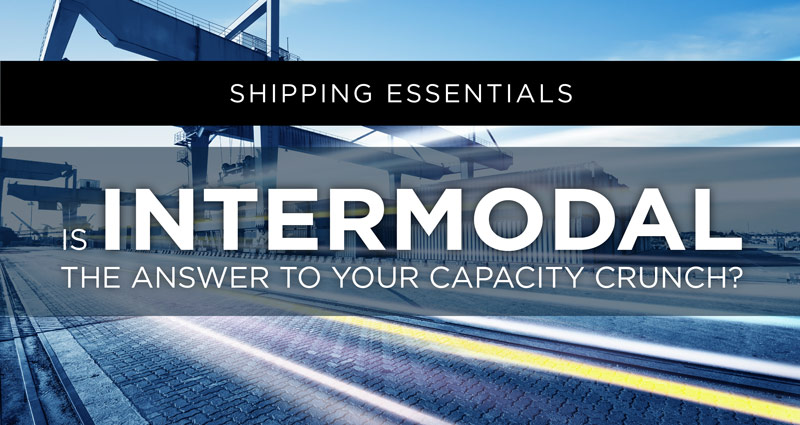Full truckload (FTL) represents a significant portion of surface-based transportation within the domestic United States for the movement of goods. As such, shippers are accustomed to shipping with FTL. Full truckload shipping is reliable and has stood the test of time. However, if there is a shortage of truck drivers, shippers can face challenges moving their freight. To avoid the pitfalls of placing all logistics-related needs into one basket, shippers can always explore other modes of transport. Enter intermodal, an alternative shipping solution.
Intermodal Shipping
Intermodal refers to moving freight using two or more modes of transport. Typically, within the U.S., this is utilized as a ‘Truck-Train-Truck’ model, in which cargo is loaded into a container at origin and uses a combination of trucks and trains to arrive at its destination. When your shipment is delivered to the next train yard, a truck driver collects it and delivers it to the designated location.
Benefits of Intermodal for Shippers
Under the right circumstances, intermodal can be an ideal solution for shippers. Here are some considerations for making effective use of the intermodal option.
Container capacity
The rail industry is one of the oldest industries in post-industrialization America. Since the invention of the combustible engine, the United States has continued to develop rail infrastructure into our domestic transportation system.
Today that means you have access to scalable intermodal capacity. Whether it be dropped trailers at your facility, handling fluctuations in specific lane volumes, or needing to displace volume onto the rail to avoid storing it in a warehouse, intermodal can fulfill several, if not all, your capacity needs.
When considering domestic intermodal programs, which utilize 53’ container sizes, intermodal rail capacity is given an “economy of scale” advantage as opposed to a fleet of trucks. One freight train can move a few hundred 53’ containers (each representing one standard truckload), while it takes one semi-truck to move one truckload.
Fuel efficiency
Trucks consume a lot of fuel. When fuel prices rise, the extra cost is transferred to the client. On the other hand, trains are fuel-efficient when viewed from a “truckload-per-gallon” perspective. Much like many of us consider efficiencies in our cars with “miles per gallon,” we can use this same approach to assess the impacts of a train hauling hundreds of truckloads.
When to Use Intermodal
Intermodal is ideal for long-haul shipments that are not time-sensitive, considering trains carry many containers simultaneously. However, capacity crunch constraints always mean that shippers must wait to get their chance. Much like the sprawling passenger-rail networks of the U.S. metropolitan areas, things don’t always work out the way that consumers hope for. When a train is late, this can put your entire vacation in jeopardy. With intermodal rail, the constraints in rail capacity (available spaces on trains), chassis capacity (available trailers to place a container on, once ready to arrive/leave train yard), and driver capacity (truck to pull container to/from origin and destination).
If you have any truckloads needing to traverse a long distance, and they are not urgent, intermodal would be your best choice as it’s the most economical transport solution.
Overcome the Capacity Crunch
Various events have challenged the traditional domestic truckload transportation market. One of the main factors is the rising demand and scarcity of drivers. A shortage of available drivers can impact the cost of freight transportation. Additionally, the more loads you need to move, the higher your truckload transportation cost. Furthermore, your shipment may sit in the yard for a long time as you struggle to find enough trucks.
For those that are time-bound and cannot be late at pickup or delivery, FTL is the best way to go. Intermodal could be an excellent alternative if the shipped product isn’t time-sensitive. And, of course, you’ll likely mix and match between FTL and its alternatives. When using intermodal as a supplemental source of capacity, shippers can manage fluctuating demand, secure reliable contract rates, and improve logistical network forecasting on an operational and financial basis. For example, it’s much easier with intermodal to get an additional ten loads per week (on a contracted basis) on a specific lane than with a contracted FTL carrier. Hence, the scalability of intermodal within your logistics network. Overall, if you’re looking for a reasonable, cost-effective alternative to full truckloads, consider intermodal.
—
The England Logistics Full Truckload division offers services for companies of all sizes. Dedicated team members are available day and night to offer solutions and assistance with all logistical needs. Regardless of the transportation mode, our market and seasonal specialists provide flexible shipping solutions and are committed to helping every step of the way.



